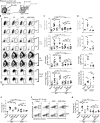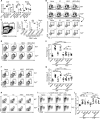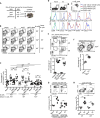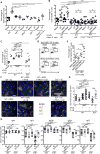Sensing Microbial Viability through Bacterial RNA Augments T Follicular Helper Cell and Antibody Responses
- PMID: 29548673
- PMCID: PMC5924674
- DOI: 10.1016/j.immuni.2018.02.015
Sensing Microbial Viability through Bacterial RNA Augments T Follicular Helper Cell and Antibody Responses
Abstract
Live vaccines historically afford superior protection, yet the cellular and molecular mechanisms mediating protective immunity remain unclear. Here we found that vaccination of mice with live, but not dead, Gram-negative bacteria heightened follicular T helper cell (Tfh) differentiation, germinal center formation, and protective antibody production through the signaling adaptor TRIF. Complementing the dead vaccine with an innate signature of bacterial viability, bacterial RNA, recapitulated these responses. The interferon (IFN) and inflammasome pathways downstream of TRIF orchestrated Tfh responses extrinsically to B cells and classical dendritic cells. Instead, CX3CR1+CCR2- monocytes instructed Tfh differentiation through interleukin-1β (IL-1β), a tightly regulated cytokine secreted upon TRIF-dependent IFN licensing of the inflammasome. Hierarchical production of IFN-β and IL-1β dictated Tfh differentiation and elicited the augmented humoral responses characteristic of live vaccines. These findings identify bacterial RNA, an innate signature of microbial viability, as a trigger for Tfh differentiation and suggest new approaches toward vaccine formulations for coordinating augmented Tfh and B cell responses.
Keywords: Bacterial RNA; CX3CR1; Follicular T helper cell; inflammasome; microbial viability; monocytes; type-I interferon; vaccine.
Copyright © 2018 Elsevier Inc. All rights reserved.
Conflict of interest statement
J.M.B. and L.E.S. have a patent related to this work: PCT/US2012/047087 “Use of Bacterial RNA or Structural Motifs thereof as adjuvants for vaccines”.
Figures






References
-
- Auffray C, Fogg D, Garfa M, Elain G, Join-Lambert O, Kayal S, Sarnacki S, Cumano A, Lauvau G, Geissmann F. Monitoring of blood vessels and tissues by a population of monocytes with patrolling behavior. Science. 2007;317:666–670. - PubMed
-
- Baumgarth N. The double life of a B-1 cell: self-reactivity selects for protective effector functions. Nat Rev Immunol. 2011;11:34–46. - PubMed
-
- Blander JM. A long-awaited merger of the pathways mediating host defence and programmed cell death. Nat Rev Immunol. 2014;14:601–618. - PubMed
-
- Blander JM, Sander LE. Beyond pattern recognition: five immune checkpoints for scaling the microbial threat. Nat Rev Immunol. 2012;12:215–225. - PubMed
-
- Broz P, Dixit VM. Inflammasomes: mechanism of assembly, regulation and signalling. Nat Rev Immunol. 2016;16:407–420. - PubMed
Publication types
MeSH terms
Substances
Grants and funding
- R01 DK111862/DK/NIDDK NIH HHS/United States
- U01 AI095613/AI/NIAID NIH HHS/United States
- R01 AI127658/AI/NIAID NIH HHS/United States
- P01 DK072201/DK/NIDDK NIH HHS/United States
- R21 AI080959/AI/NIAID NIH HHS/United States
- R01 AI073899/AI/NIAID NIH HHS/United States
- P01 AI061093/AI/NIAID NIH HHS/United States
- R01 AI057653/AI/NIAID NIH HHS/United States
- R01 AI095245/AI/NIAID NIH HHS/United States
- R56 AI073899/AI/NIAID NIH HHS/United States
- R01 DK113136/DK/NIDDK NIH HHS/United States
- R01 AI123284/AI/NIAID NIH HHS/United States
LinkOut - more resources
Full Text Sources
Other Literature Sources
Molecular Biology Databases

